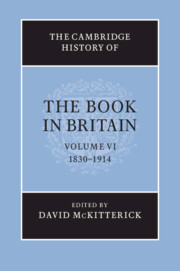Book contents
- Frontmatter
- Introduction
- 1 Changes in the look of the book
- 2 The illustration revolution
- 3 The serial revolution
- 4 Authorship
- 5 Copyright
- 6 Distribution
- 7 Reading
- 8 Mass markets: religion
- 9 Mass markets: education
- 10 Mass markets: children’s books
- 11 Mass markets: literature
- 12 Science, technology and mathematics
- 13 Publishing for leisure
- 14 Publishing for trades and professions
- 15 Organising knowledge in print
- 16 The information revolution
- 17 A place in the world
- 18 Second-hand and old books
- 19 A year of publishing: 1891
- 20 Following up The reading nation
- Bibliography
- Index
- Plate Sections
- References
7 - Reading
Published online by Cambridge University Press: 28 March 2010
- Frontmatter
- Introduction
- 1 Changes in the look of the book
- 2 The illustration revolution
- 3 The serial revolution
- 4 Authorship
- 5 Copyright
- 6 Distribution
- 7 Reading
- 8 Mass markets: religion
- 9 Mass markets: education
- 10 Mass markets: children’s books
- 11 Mass markets: literature
- 12 Science, technology and mathematics
- 13 Publishing for leisure
- 14 Publishing for trades and professions
- 15 Organising knowledge in print
- 16 The information revolution
- 17 A place in the world
- 18 Second-hand and old books
- 19 A year of publishing: 1891
- 20 Following up The reading nation
- Bibliography
- Index
- Plate Sections
- References
Summary
The meaning of reading
Since the 1980s the idea that readers invest printed objects with their own expectations and actively construct meaning, rather than finding it already inscribed in the text, has transformed the way in which we think about the history of reading. It is no longer enough to document what was being produced in the past; we now also need to discover how these objects were consumed. As Guglielmo Cavallo and Roger Chartier have argued, however, the reader is never entirely free to make meaning. Reading is always constrained by the protocols of reading embedded within texts, as well as by modes of access or communication, such as oral recitation. It is a skill that is taught and during this training the student also learns a set of meanings that it is legitimate to ascribe to certain texts, or to the act of reading itself, within his or her reading community. They conclude that, despite the appearance of an increasingly common culture throughout Europe by the end of the nineteenth century, in part due to the intervention of the nation-state in the teaching process, there was in fact ‘an extreme diversity in both reading practices and markets for the book (or newspaper)’ throughout this period.
Recent studies of reading have gone some way to unearthing the range of practices used by readers during the nineteenth and twentieth centuries. Much of this work has concentrated upon the discourse of reading that helped to discipline or legitimate what readers did with texts. Kate Flint’s The woman reader 1837–1914, for example, looks at the ‘wide range of contexts in which “the woman reader” was constructed as a discrete topic’, including advice manuals, periodicals, ‘paintings, photographs and graphic art’, in order to suggest that women’s reading was often overdetermined by this discourse.
Keywords
- Type
- Chapter
- Information
- The Cambridge History of the Book in Britain , pp. 281 - 323Publisher: Cambridge University PressPrint publication year: 2009
References
- 5
- Cited by



